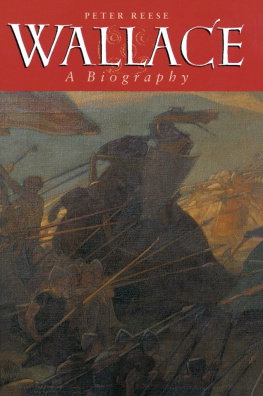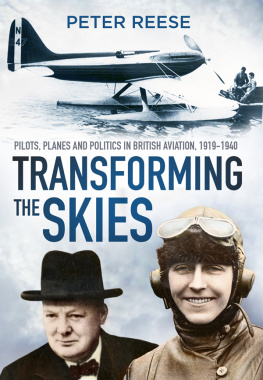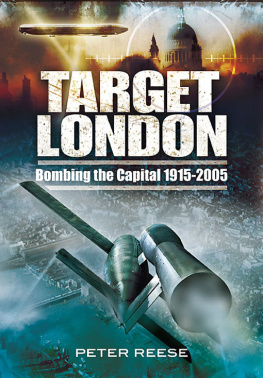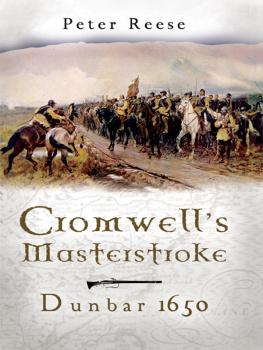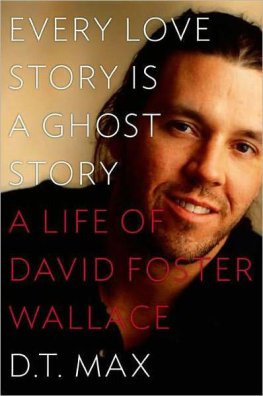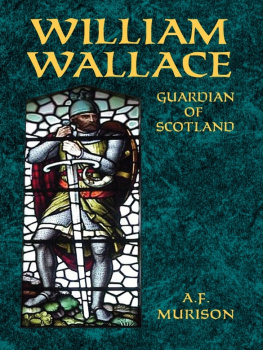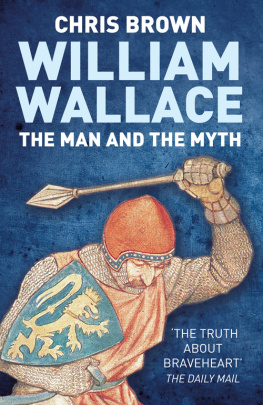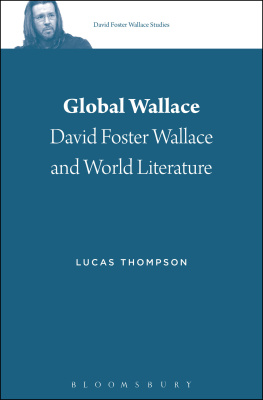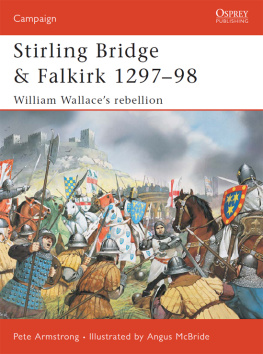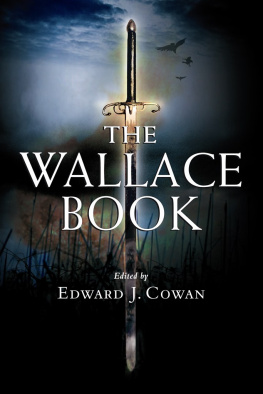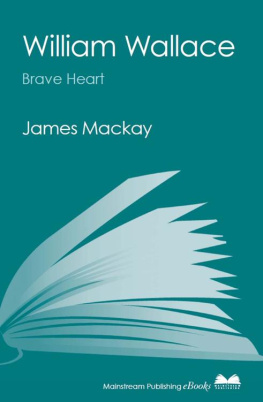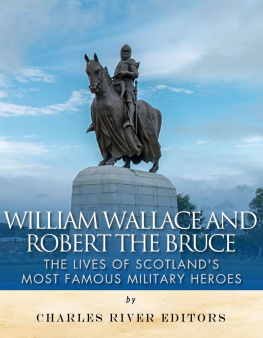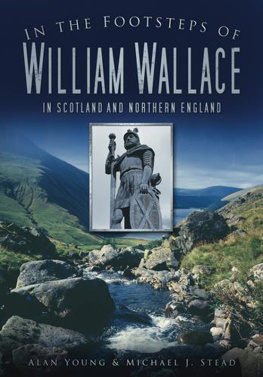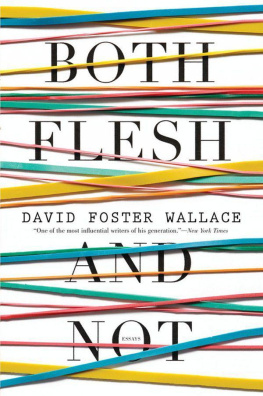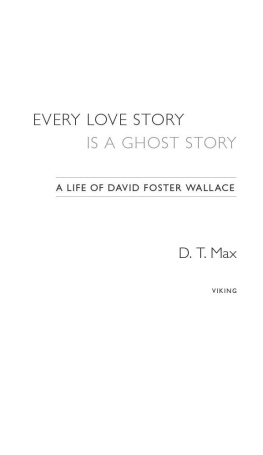
Portrait of William Wallace reproduced by Schenck and McFarlane of Edinburgh from an original reputedly sold by Cromwell out of the English Royal Collection of Charles I; courtesy of Renfrew District Council (Paisley Museum).

For Barbara, my wife
First published in Great Britain in
1996 by Canongate Books Ltd,
14 High Street, Edinburgh
This digital edition first published in 2012 by Canongate Books
Copyright Peter Reese, 1996
All rights reserved
ISBN 0 86241 607 8
eISBN 978 1 78211 085 9
British Library Cataloguing-in-Publication Data
A catalogue record for this book is available on request from the British Library
Typeset by Hewer Text Composition Services,
Edinburgh
www.canongate.tv
The Scottish Succession
as it relates to the main claimants in the Great Cause of 1291-92

ACKNOWLEDGEMENTS
I N THE DAYS BEFORE many dual-carriage roads or extensive motorways, whenever I drove to the far north I would break my journey at Stirling. After long hours in a car I relished climbing up to the Castle from where I would gaze across the wide plain intersected by the shimmering Forth towards the dark prominence of Abbey Craig topped by its great monument. As I repeated the ritual I became ever more determined to learn about the man it commemorated.
For the germ of an idea to become a published work I owe very much to many people. The staffs of the British Library, the National Library of Scotland, the Edinburgh Central Library and Stirling Reference Library have been most helpful. The text was largely written in my second home, the Prince Consorts Military Library, Aldershot, and I would like to thank the present librarian, Mr Tim Ward; the Armys Systems librarian, Mr Paul Vickers, who has also produced excellent battle plans, maps and tables; Mrs Alice Alexander; Mrs Linda Surman; Mrs Pam Parker; Mrs Jean Duffield; Mrs Gail Ward and Mrs Elaine Edwards.
At St Andrews University I benefited from Ronald Cants deep knowledge and ageless enthusiasm; in Edinburgh Professor Geoffrey Barrow was kind enough to discuss William Wallace with me and to appear persuaded that another biography of the great man was not unreasonable; at Falkirk, archeologist Geoffrey Bailey and local historian John Walker fielded my many queries on the battle of Falkirk and at Bridge of Allan Craig Mair helped me straighten out some of my ideas and much else besides.
In England my old and valued friend Dr Leslie Wayper reacted in his inimitable fashion to concepts yet unformed; Mrs Jennifer Prophet did wonders for the style and, together with her son Charles, produced the index, while Colonel Mike Wellings gave me his honest and clear reactions. Mrs Christine Batten put her word processor to wonderful effect transforming idiosyncratic handwriting into a legible form and then amended things more times than I like to remember.
I am greatly indebted to my publisher Hugh Andrew of Canongate Books for taking up the script of an Englishman who dared to write about one of Scotlands greatest heroes; Dr Richard Oram as historical editor, Neville Moir who brought the text to the production stage and Duncan McAra as textual editor.
Any shortcomings are, of course, mine alone.
Peter Reese

Scotland: Language Division

Roman Scotland

Scottish Medieval Burghs
PROLOGUE

STIRLING REMEMBERS
Still is thy name in high account.
Sir Walter Scott
O N 23 JUNE 1861 it was raining in Stirling, whose towering castle had often barred invaders venturing northwards, and in whose vicinity two battles vital to the independence of Scotland had taken place. But by mid-morning the sun broke through and it turned out clear and dry, with that pleasing freshness that often follows heavy rain. Townsfolk on the castle rock, gazing at Abbey Craig two miles away had no difficulty in making out the sharp outlines and different shades of green among the trees covering that lesser but still dominant outcrop. The weather was fortunate, for large numbers of people were on their way to the burgh. Their purpose this time was not to oppose English invaders but to take part in a great celebration. That afternoon many of them, in all manner of formal dress, would march from the town to Abbey Craig. Once there they were due to take part in a ceremony to commemorate their great compatriot William Wallace who, almost 564 years before, brought his men rushing down that hill to defeat a superior English army as it crossed the meandering but wide river Forth.
The Victorians loved to erect triumphal monuments and statues and Stirling was in festive mood. Wreaths of evergreens topped by a royal standard hung across its main thoroughfare, Murray Place, while in the village of Causewayhead, between Stirling and Abbey Craig, where in Wallaces time most invading armies passed northwards, a wooden arch had been built. This was also decked with evergreens and surmounted by two flagstaffs. As day-excursion trains pulled into Stirling station travellers found it decorated with flags and other emblems while outside two medals struck to commemorate the event were on sale. While not everyone could afford the medals, all could mingle with their fellow onlookers and share a sense of growing excitement heightened by the proud strains of military bands. There was, too, the clopping of horses hooves mingled with the rattle of their harnesses, while seemingly from every corner came the measured tread of marching feet.
In other nearby towns, such as Alloa and Falkirk and in Stirlings neighbouring villages on both sides of the Forth, business activity came to a halt. In many cases those involved in the festivities had declared local holidays, to release others who wanted to watch. In addition to those travelling by train people came by road, riding in horse omnibuses decorated with evergreens, in farmers carts, on horseback or on foot. More than 80,000 visitors converged on a town where the population was just 10,000 and its neighbouring villages often had less than two hundred people.
All knew that they were marking the memory of an outstanding Scottish hero, even if to many his deeds were but sketchily known. Most were aware he had gained a great victory against the English invaders near Abbey Craig. Wasnt this where the foundation stone of the monument would be laid? But details about an event so long ago were scarce. Only the better-informed understood how Wallaces victory had gained precious time for Robert Bruce to emerge to pick up the sword and subsequently defeat the English at nearby Bannockburn. The connection between Wallaces victory at Stirling Bridge and Scotlands continuing independence for the best part of 400 years until, by the Act of Union (1707), it could join its larger neighbour with its traditions intact, was not immediately obvious. In any case for many attending, however patriotic, the historical details were less important than the spectacle which was to come. For the vast majority, it was the great procession to Abbey Craig which was
Next page
